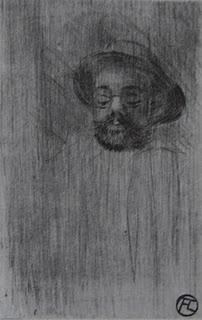 Henri de Toulouse-Lautrec, Henry SommDrypoint, 1898Reproduced from Adriani, Toulouse-Lautrec The Complete Graphic Works
Henri de Toulouse-Lautrec, Henry SommDrypoint, 1898Reproduced from Adriani, Toulouse-Lautrec The Complete Graphic WorksToulouse-Lautrec and Somm knew each other as habituées of seedy Montmartre dives such as Le Chat Noir or the gay and lesbian hang-out Le Rat Mort (whose menu was illustrated by Somm). They were also both members of a proto-Dadaist anti-establishment art group, Les Incohérents. This playfully anarchic parody of an art movement was made up of various Chat Noir regulars, including Henry Somm, Adolphe Willette, and its instigator, the playwright Jules Lévy. According to Lautrec's biographer Julia Frey, he had an entry hung in the third annual exhibition of the Incohérents in 1886, a parody of the Stone Age paintings of his teacher, Fernand Cormon. As Somm's etching Les peuples hospitaliers shows, he was not averse to poking sly fun at the same target. Julia Frey writes of Les Incohérents, "At last Henry [Toulouse-Lautrec] had found a spiritual home. Constitutionally incapable of joining any theoretical school of art, he found his closest philosophical match in the Incohérents, who refused to be a school at all, who had no consistent membership, and who thumbed their noses at all 'serious art'."
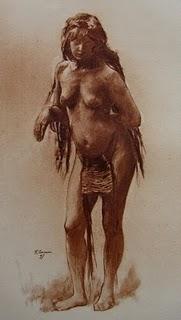 Fernand Cormon, WomanEtching with aquatint by André Devambez after Cormon, 1921
Fernand Cormon, WomanEtching with aquatint by André Devambez after Cormon, 1921 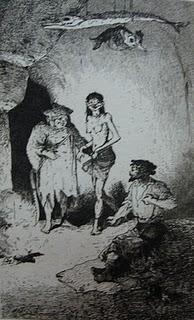 Henry Somm, Les peuples hospitaliersEtching, 1879
Henry Somm, Les peuples hospitaliersEtching, 1879Somm was born François-Clément Sommier in Rouen in 1844. By the time he settled in Paris he was known as Henry Somm, the name under which in 1870 he illustrated his first book, La Rapinéide. This book reprinted an obscure verse skit of 1838 on the japes and high-jinks of art students. The full title is La Rapinéide ou L’Atelier, poème burlesco-comico-tragique en 7 chants, par un ancien rapin des ateliers Gros et Girodet. In terms of understanding Henry Somm, the key word in that title is “comico”. He had an essentially humorous turn of mind, and while some of his wit is satirical, much of it revels in sheer nonsense and horseplay. He was an indefatigable contributor of comical sketches to the press: La Charge, Le Cravache, Chronique Parisienne, High-Life, Frou-Frou, and Le Rire were among the publications where you might expect to encounter cartoons by Henry Somm.
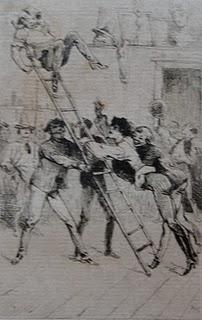 Henry Somm, La rapinéide: chant premierEtching, 1870
Henry Somm, La rapinéide: chant premierEtching, 1870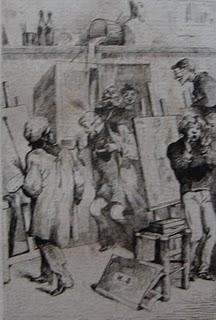 Henry Somm, La rapinéide: chant deuxièmeEtching, 1870
Henry Somm, La rapinéide: chant deuxièmeEtching, 1870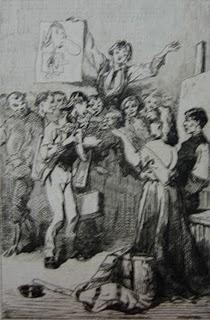 Henry Somm, La rapinéide: chant troisièmeEtching, 1870
Henry Somm, La rapinéide: chant troisièmeEtching, 1870 Henry Somm, La rapinéide: chant sixièmeEtching, 1870
Henry Somm, La rapinéide: chant sixièmeEtching, 1870As the friendship with Toulouse-Lautrec indicates, Henry Somm was very much part of the nightlife of Montmartre, most particularly through his involvement in the nightclub Le Chat Noir. In 1885 Somm and George Auriol set up the famous théâtre d’ombres in Le Chat Noir. Although the most famous creator of shadow-plays for this raffish venue was Henri Rivière, the first production was Somm’s L’Éléphant. This play, and others such as La Berline de l’émigré and Cythère à Montmartre , are now regarded as important precursors of Alfred Jarry’s Ubu plays, and by extension of the entire Theatre of the Absurd. The connections between Somm and Jarry have been explored in an essay by art historian Elizabeth K. Menon with the wonderful title Potty-talk in Parisian Plays. I’ve only been able to find scraps of this on the net, so don’t know if Menon takes the story further back to the absurdist playlet La Maison de fous by Richard Lesclide, which Somm illustrated with etchings in 1876. These appeared both in a book and in the journal Paris à l’eau-forte, which was edited by Lesclide. This play and others by Lesclide such as La Diligence de Lyon, which is famously based on an unresolved dirty joke, also anticipate the theatre of the absurd.
 Henry Somm, Le poèteEtching, 1876This and the three following are for Richard Lesclide's playLa Maison de fous
Henry Somm, Le poèteEtching, 1876This and the three following are for Richard Lesclide's playLa Maison de fous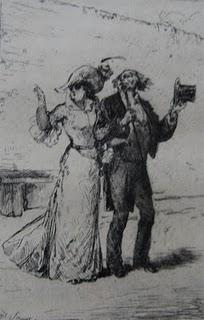 Henry Somm, Rosine et le docteurEtching, 1876
Henry Somm, Rosine et le docteurEtching, 1876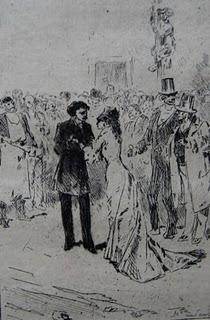 Henry Somm, Les fousEtching, 1876
Henry Somm, Les fousEtching, 1876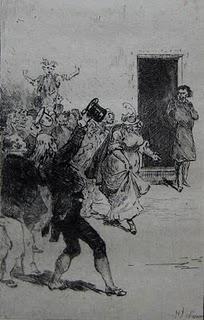 Henry Somm, Le mariageEtching, 1876
Henry Somm, Le mariageEtching, 1876Henry Somm’s appearance as a contributor to Paris à l’eau-forte comes as no surprise. Both of the art editors of this short-lived journal (1873-1876), Frédéric Regamey and his successor Henri Guérard, were passionate Japonistes, and so was Henry Somm. Another article by Elizabeth K. Menon, The Functional Print in Commercial Culture: Henry Somm’s Women in the Marketplace (available in full here) explores Somm’s Japonisme. At the urging of Siegfried Bing and Philippe Burty, Somm enrolled in Léon de Rosny’s courses in Japanese language and history at the University of Paris. After two years of study, Somm intended to travel to Japan in 1870, funded by the French State, but his plans were derailed by the Franco-Prussian war. He remained in Paris, and his Japan remained very much a country of the imagination rather than an experienced reality. Japanese objects and figures feature in some of Somm’s prints, such as the 1881 etching entitled Japonisme, but the actual Japanese influence on his art is quite subtle and hard to define. Elizabeth K. Menon locates it in the Japanese tradition of mitate, or parody, a method in which a satiricial or humorous point is made by “an amusing juxtaposition of two unlike ideas”. Her argument is quite complex, and I urge you to read it in full. Elizabeth K. Menon (now Elizabeth K. Mix) appears to be the only scholar to have made a serious study of Henry Somm, and has also published Henry Somm: Impressionist, Japoniste or Symbolist? in Master Drawings 33, no. 1 (Spring, 1995).
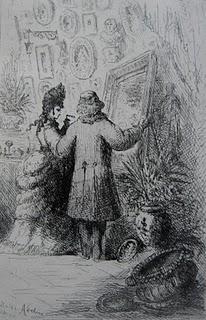 Jules Adeline, L'antiquaireEtching, 1874
Jules Adeline, L'antiquaireEtching, 1874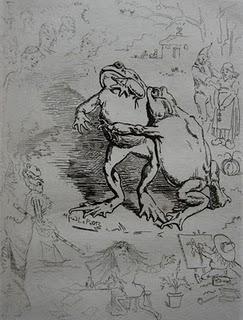 Alfred Marie Le Petit and Henry SommPrintemps, Etching and drypoint, 1876
Alfred Marie Le Petit and Henry SommPrintemps, Etching and drypoint, 1876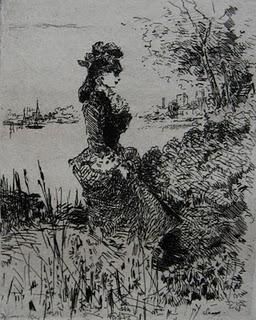 Henry Somm, La dame au sonnetEtching, 1876
Henry Somm, La dame au sonnetEtching, 1876Before coming to Paris, Henry Somm studied at the École de Dessin Municipale in Rouen, under Gustave Morin. Two fellow-students who became his lifelong friends were Alfred Le Petit and Jules Adeline. It seems likely that all three came to Paris together, probably in 1867, and that all three fell under the spell of Japonisme together. Jules Adeline was the first of the three to contribute to Paris à l’eau-forte, presumably through a connection with Frédéric Regamey, but before long Le Petit and Somm were also contributing. I have one plate, Printemps, which, eccentrically, is worked and signed by both Le Petit (who etched the two lovesick frogs in the centre), and Somm, who added drypoint remarques around the edge, including a self-portrait at the easel. This method of surrounding an image with remarques was typical of Félix Buhot, another Japoniste, and was employed by Henry Somm on several occasions.
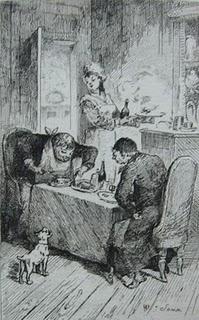 Henry Somm, Les femmes dévotesEtching, 1879
Henry Somm, Les femmes dévotesEtching, 1879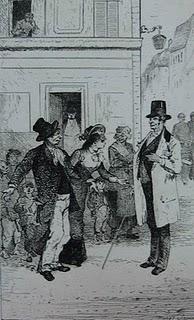 Henry Somm, L'utilité de la loi contre l'ivresseEtching, 1879
Henry Somm, L'utilité de la loi contre l'ivresseEtching, 1879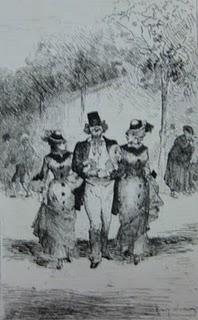 Henry Somm, La femme auxiliaireEtching, 1879
Henry Somm, La femme auxiliaireEtching, 1879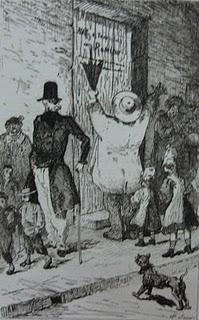 Henry Somm, Le gendre des RomigusEtching, 1879
Henry Somm, Le gendre des RomigusEtching, 1879 Henry Somm, Le troisième conviveEtching, 1879
Henry Somm, Le troisième conviveEtching, 1879 Henry Somm, Les deux soeursEtching, 1881
Henry Somm, Les deux soeursEtching, 1881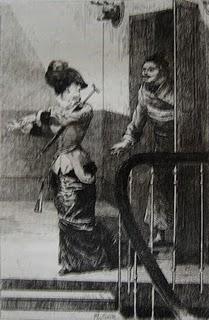 Henry Somm, Jeanne-qui-rit, Jeanne-qui-pleurEtching, 1881
Henry Somm, Jeanne-qui-rit, Jeanne-qui-pleurEtching, 1881 Henry Somm, L'équipée de GoudoulyEtching, 1881
Henry Somm, L'équipée de GoudoulyEtching, 1881A socially-aware side to Henry Somm emerges in his etchings for three works by Auguste Saulière: Les leçons conjugales (1879), Histoires conjugales (1881), and Ce qu’on n’ose pas dire (1884). In these works, the gaiety of Somm’s humour is tempered by a strong sense of inequality and tension between the sexes. A deceitful lover promises the moon to a naive poor girl; an elegantly dressed young woman is despatched to walk the streets; the viewer is invited to “allez dans les cafés et sur les boulevards” to witness the reality of child prostitution. Elizabeth K. Menon discerns in Somm’s work a fear of women as potentially dangerous and manipulative, but in these etchings his fear is predominately for the female characters, not of them.
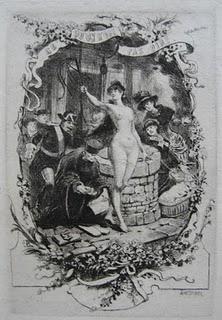 Fernande Auguste Besnier, Ce qu'on n'ose pas direEtching, 1884The frontispiece to Ce qu'on n'ose pas dire was this Symbolist etchingby the up-and-coming young illustrator Fernande Besnier
Fernande Auguste Besnier, Ce qu'on n'ose pas direEtching, 1884The frontispiece to Ce qu'on n'ose pas dire was this Symbolist etchingby the up-and-coming young illustrator Fernande Besnier Henry Somm, Mais qui contentera sa femme et sa maîtresseEtching, 1884
Henry Somm, Mais qui contentera sa femme et sa maîtresseEtching, 1884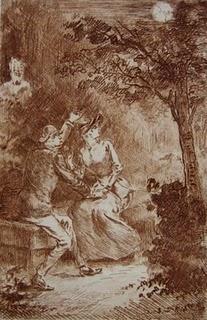 Henry Somm, Promet la lune à la pauvretteEtching, 1884
Henry Somm, Promet la lune à la pauvretteEtching, 1884 Henry Somm, Allez dans les cafés et sur les boulevardsEtching, 1884
Henry Somm, Allez dans les cafés et sur les boulevardsEtching, 1884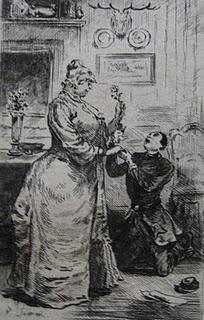 Henry Somm, Tous les collegiens aiment les dames mûresEtching, 1884
Henry Somm, Tous les collegiens aiment les dames mûresEtching, 1884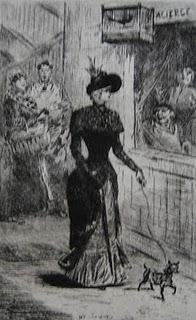 Henry Somm, Oui les langues leurs sont sévèresEtching, 1884
Henry Somm, Oui les langues leurs sont sévèresEtching, 1884Henry Somm made the Parisienne the central focus of his art, and no doubt over the course of his career one could construct almost any argument one liked about his sexual politics. For instance he did in 1876 provide a frontispiece for Jacques Olivier’s misogynistic Alphabet de l’imperfection et malice des femmes. But it is clear to me from his delicate drypoint chapter-heads and tail-pieces for Les Cousettes by Louis Morin (1895) that Henry Somm felt great tenderness and sympathy for Paris’s army of exploited young seamstresses, who had little option other than to prostitute themselves in order to live.
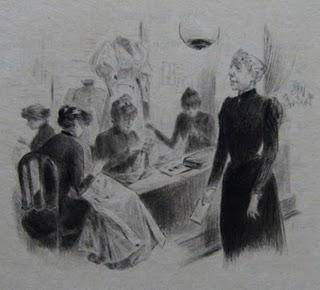 Henry Somm, Les cousettes - L'ouvrière (I)Drypoint, 1895
Henry Somm, Les cousettes - L'ouvrière (I)Drypoint, 1895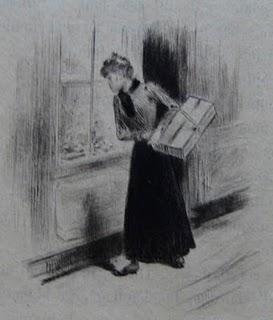 Henry Somm, Les cousettes - L'ouvrière (II)Drypoint, 1895
Henry Somm, Les cousettes - L'ouvrière (II)Drypoint, 1895 Henry Somm, Les cousettes - L'état-major de la couture (II)Drypoint, 1895
Henry Somm, Les cousettes - L'état-major de la couture (II)Drypoint, 1895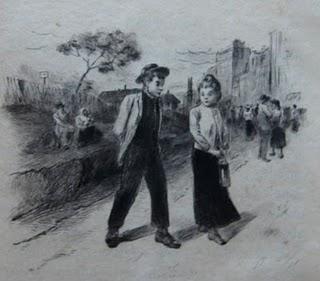 Henry Somm, Les cousettes - Le p'tit amoureux (I)Drypoint, 1895
Henry Somm, Les cousettes - Le p'tit amoureux (I)Drypoint, 1895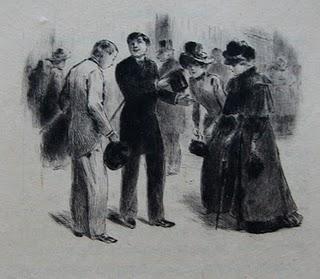 Henry Somm, Les cousettes - Le premier amant (I)Drypoint, 1895
Henry Somm, Les cousettes - Le premier amant (I)Drypoint, 1895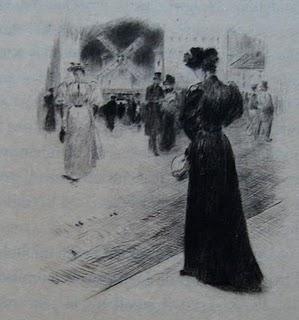 Henry Somm, Les cousettes - Conclusion (II)Drypoint, 1895
Henry Somm, Les cousettes - Conclusion (II)Drypoint, 1895My last set of drypoints by Henry Somm was made in 1897 for La Parisienne peinte par elle-même by Georges Montorgueil. Here all the background of street or interior which we find in the earlier work has been stripped away, so that only the woman exists. These exquisite Parisiennes seem unreachably lost in their own interior worlds—not so much offered up to the male gaze as glimpsed through a portal into some other dimension. Where the model is aware of our gaze, she returns it with a sense of amused impatience, eager to be set free once more to her own thoughts and purposes.
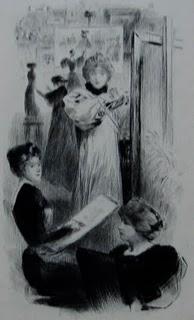 Henry Somm, La Parisienne (frontispiece)Drypoint, 1897
Henry Somm, La Parisienne (frontispiece)Drypoint, 1897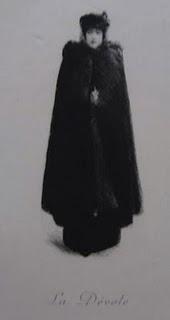 Henry Somm, La DévoteDrypoint, 1897All 21 of Somm's drypoints for La Parisienne have their titles printed within the plate as above
Henry Somm, La DévoteDrypoint, 1897All 21 of Somm's drypoints for La Parisienne have their titles printed within the plate as above Henry Somm, La petite Bonne DuvalDrypoint, 1897
Henry Somm, La petite Bonne DuvalDrypoint, 1897 Henry Somm, Le TrottinDrypoint, 1897
Henry Somm, Le TrottinDrypoint, 1897Much of Henry Somm’s work has become very scarce. Journals that were issued in runs of thousands become hard to find very quickly, while items such as menus, invitations, programmes, ex libris and cartes-de-visite, all of which Somm decorated with etched vignettes, are the very definition of ephemera. His individual plates seem to have been issued in very small numbers, and the books too were always limited. La rapinéide was published by Barraud in an edition of 500 copies on various papers, printed by Jules Bonaventure. Les leçons conjugales was a “tirage à petit nombre” on wove paper, with 100 copies on laid paper with the etchings avant la lettre on Japon, and 50 copies on Chine with the etchings avant la lettre. I also have 3 of the etchings for this as published in Paris à l’eau-forte in 1876; it may be that Richard Lesclide intended to publish this book himself from his associated press, Librairie de l’eau-forte, but his business failed, he took the post of secretary to Victor Hugo, and Les leçons conjugales was published three years later by E. Dentu. The same publisher issued Histoires conjugales and Ce qu’on n’ose pas dire, in the same print-runs, except for the latter he added 20 copies on Japon. My copy of Ce qu’on n’ose pas dire has an extra set of the etchings without letters, all printed in black on Chine except for one in sanguine on Japon; the copy itself is one of the ordinary ones on vélin teinté, suggesting that possibly purchasers could add on a suite of the etchings if they so desired. My copy of Les leçons conjugales, incidentally, came from the Bibliothèque du 22me d’Infanterie, and bears their collection stamp on every plate, which I rather cherish, though I guess not everyone would like it. The etchings in all 3 books (and in Paris à l’eau-forte) were printed by Delâtre.
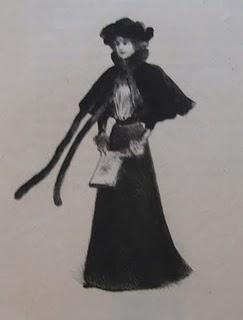 Henry Somm, L'ActeuseDrypoint, 1897
Henry Somm, L'ActeuseDrypoint, 1897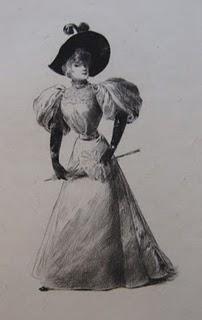 Henry Somm, La Demi-mondaineDrypoint, 1897
Henry Somm, La Demi-mondaineDrypoint, 1897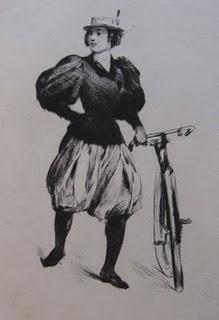 Henry Somm, La BicyclisteDrypoint, 1897
Henry Somm, La BicyclisteDrypoint, 1897The later books were even more limited. Les Cousettes was published in an edition of 100 copies, all on Japon; La Parisienne in an edition of 150 copies, all on Hollande. The publisher in both cases was Librairie L. Conquet, and the drypoints were printed by Wittmann.
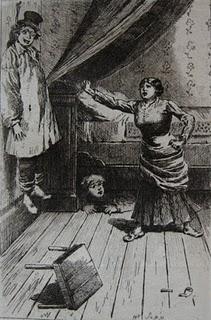 Henry Somm, La femme muetteEtching, 1881
Henry Somm, La femme muetteEtching, 1881Despite—or perhaps because of—his lifelong obsession with “la Parisienne”, I can’t find any reference to Henry Somm having married, and I rather suspect he did not. He died of natural causes in his studio at 27 boulevard de Rochechouart in Montmartre in the same year as Alfred Jarry, 1907. In Elizabeth K. Menon’s words, both men died “penniless and forgotten by all but their closest friends”. But Henry Somm was given a retrospective exhibition in 1911 at Galerie Berthe Weill, and he has not been completely forgotten. His art has a strange inextinguishable sense of life to it, as the critic Roger-Milès noted in his preface to a sale catalogue in 1897: “Henry Somm est de ceux dont l’art, qui semble fugitif, est fait de qualités solides; il a le viatique qui empêche de disparaître.” I think this means: Henry Somm is among those whose art, which appears fugitive, is made of solid qualities; it has the viaticum [Holy Communion administered as the last rites] which prevents it from dying.

